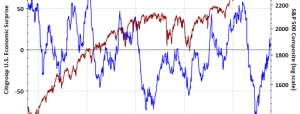Where Does Money Come From?
Image Source: All money is lent into existence. The Federal Reserve or the government does not print money. Those two facts are vital to understanding our lead question: where does money come from? Furthermore, knowing who does and doesn’t print money and the incentives and disincentives that change the money supply are critical to inflation forecasting. Some so-called bond vigilantes are running around like Chicken Little, warning that the Fed’s recent rate cuts will increase inflation. They fail to understand the two lead facts. Moreover, and somewhat ironic, the Fed’s shift to a dovish monetary policy has been hawkish and disinflationary on the margin.A dovish-hawkish policy description may sound crazy, but read on. With a better appreciation of how money is created, you will see that inflation fears driven by Fed actions may be misplaced. Furthermore, inflation concerns are significantly impacting bond yields. Opportunity may lay in wait for those who appreciate how the money supply impacts inflation. What Is Inflation?Economist Milton Friedman once stated, “Inflation is always and everywhere a monetary phenomenon.” Basically, the more money, the more inflation, and vice versa.That’s half the story. Economics 101 teaches that the changing supply of a good or service AND the demand for said good or service determines price changes.Demand is a function of the amount of money and credit in the financial system. Furthermore, it’s not just about the amount of money in the system, as Friedman alludes, but the desire to spend it.Left out of Friedman’s infamous quote, supply is equally important to the inflation equation. […]
Daily Market Outlook – Wednesday, Feb. 5
Image Source: As investors navigate trade dispute dynamics and await earnings reports from major tech companies on Wall Street, Asian stocks rose in line with US shares. However, Chinese markets dropped upon reopening. Following the Lunar New Year holidays, China’s stock market saw a decline on Wednesday, while Asian shares experienced an increase for the second consecutive day. After Alphabet and AMD suffered losses during after-hours trading, contracts for US and European stocks also fell. Increased demand for safe-haven assets propelled gold to a record high, and the Yen gained strength against the Dollar. Asian tech stocks mirrored the upward movement of their US counterparts, even as investor sentiment turned cautious regarding China, which retaliated shortly after the US imposed a 10% tariff on all imports from the country. The opening moves in the latest US-China trade conflict indicated that Xi is adopting a more conservative stance compared to Trump’s first term. The Yen appreciated in value due to solid domestic wage data and official comments about inflation, raising expectations that the Bank of Japan would continue increasing interest rates. Fears that the trade war could impede global economic growth overshadowed the announcement of stricter sanctions on Iran, resulting in a slight decline in commodities like oil.Hamas representative Sami Abu Zuhri condemned U.S. President Donald Trump’s suggestion of taking over the Gaza Strip, describing it as “ridiculous” and warning that such proposals could destabilise the Middle East. Trump proposed U.S. control over Gaza to focus on its economic development following […]
BoE Interest Rate Decision And US NFP Report In Spotlight
The Bank of England (BoE) interest rate decision and the US Nonfarm Payrolls (NFP) report will be the two data releases to draw attention for the remainder of the week. Market participants still discuss Donald Trump’s tariff plans although the Canada and Mexico cases are on pause for the next thirty days.Stock markets shook off tariff fears with South Korea’s Kospi and Japan’s Nikkei 225 indices rising on Wednesday. In other news, , forcing the company’s share value to drop. Another report revealed that the fourth-quarter data center sales of Advanced Micro Devices (AMD) missed estimates while net income fell significantly. Bank Of England Interest Rate DecisionOn Thursday morning, the Bank of England’s Monetary Policy Committee (MPC) will convene to decide on interest rates. Economists suggest that the MPC will cut rates by 25 basis points, leading the benchmark interest rate to 4.50%.A series of reports coming from the UK showed that the economy was still under pressure with retail sales and services inflation dropping. Weak figures could force the BoE to loosen its monetary policy with market analysts forecasting a total of 100 basis points rate cuts during this year.Economists at ING noted in a report that “expect its policy statement to simply reiterate that further gradual easing is likely, without any comments about timing. But don’t ignore the risk of more aggressive easing later this year. Markets have a tendency of lumping the BoE in the same category as the Fed, despite the macro story looking increasingly different in the […]
Three Important Markets: How Do They Fare In Post-Election Years?
You may have heard of the election cycle.As happened last year, a US president is elected every four years. The result of these elections impacts markets beyond just Election Day, every four years of the election cycle.Contrary to what many investors think, it is not so much the election outcome that has an impact on prices.Rather, it is which year of the four-year election cycle that we are in that matters to the markets.This is what I want to look at today for three markets: gold, the US dollar and technology stocks. Gold in Post-Election YearsFirstly, let’s look at gold. The chart below shows you the typical development of gold in post-election years.In a sense, it is a seasonal chart in which only every fourth year is included in the calculation.This chart shows you the average trend of gold in post-election years from 1969 onwards. Gold, typical course of post-election years only, 1969 to 2024After a weak start, prices rise until the beginning of August. Source: Gold typically rises in post-election years with strong fluctuations until early June.Seen this way, the way for higher gold prices is now!After this year, there is an overall cyclical sideways movement. The US dollar in post-election yearsCurrencies also depend on the election cycle.The next chart shows you the typical development of the US dollar index in post-election years.USDX, typical course of post-election years only, 1969 to 2024The dollar has been going sideways for months. Source: You can see that from the beginning of February in post-election […]
USD/CHF Holds Losses Below 0.9050 As US Dollar Undergoes A Downward Correction
Photo by on USD/CHF loses ground as the US Dollar weakens for the third consecutive session on Wednesday. Safe-haven demand for the Swiss Franc rises due to escalating US-China trade tensions. Traders await Thursday’s Swiss Unemployment Rate to gain further insight into the labor market. USD/CHF continues its decline for the second straight day, trading near 0.9030 during European hours on Wednesday. This downturn is primarily driven by a weaker US Dollar (USD), which is undergoing a technical correction.The US (DXY), which tracks the USD against six major currencies, remains under pressure for the third consecutive session, hovering around 107.70 at the time of writing. Meanwhile, market participants await Friday’s US (NFP) data, which could influence the Federal Reserve’s (Fed) monetary policy stance.Adding to the USD’s weakness, US President Donald Trump has agreed to a 30-day suspension of the proposed 25% tariffs on Canadian and Mexican imports. This decision follows commitments from Canadian Prime Minister Justin Trudeau and Mexican President Claudia Sheinbaum to enhance border security in response to concerns over illegal immigration and drug trafficking.Further weighing on the pair, safe-haven demand for the Swiss Franc (CHF) could have increased due to escalating US-China trade tensions. In retaliation for the new 10% US tariff imposed on Tuesday, China has implemented a 15% tariff on US coal and liquefied natural gas (LNG) imports, along with an additional 10% tariff on crude Oil, farm equipment, and certain automobiles.On the Swiss economic front, the SVME Purchasing Managers’ Index (PMI) inched up to 47.5 in January from […]







